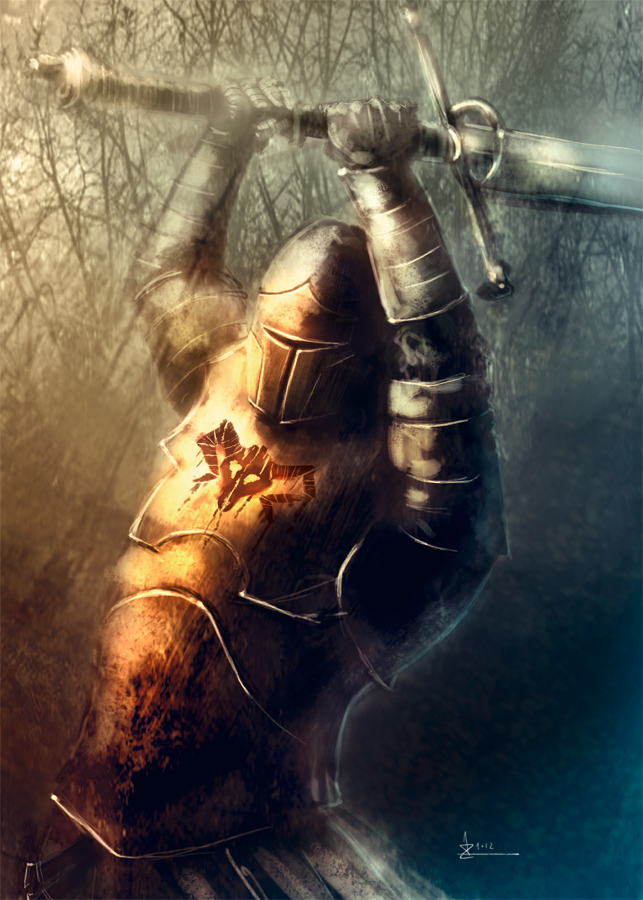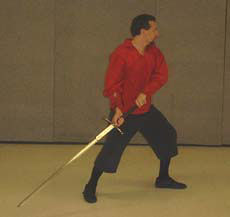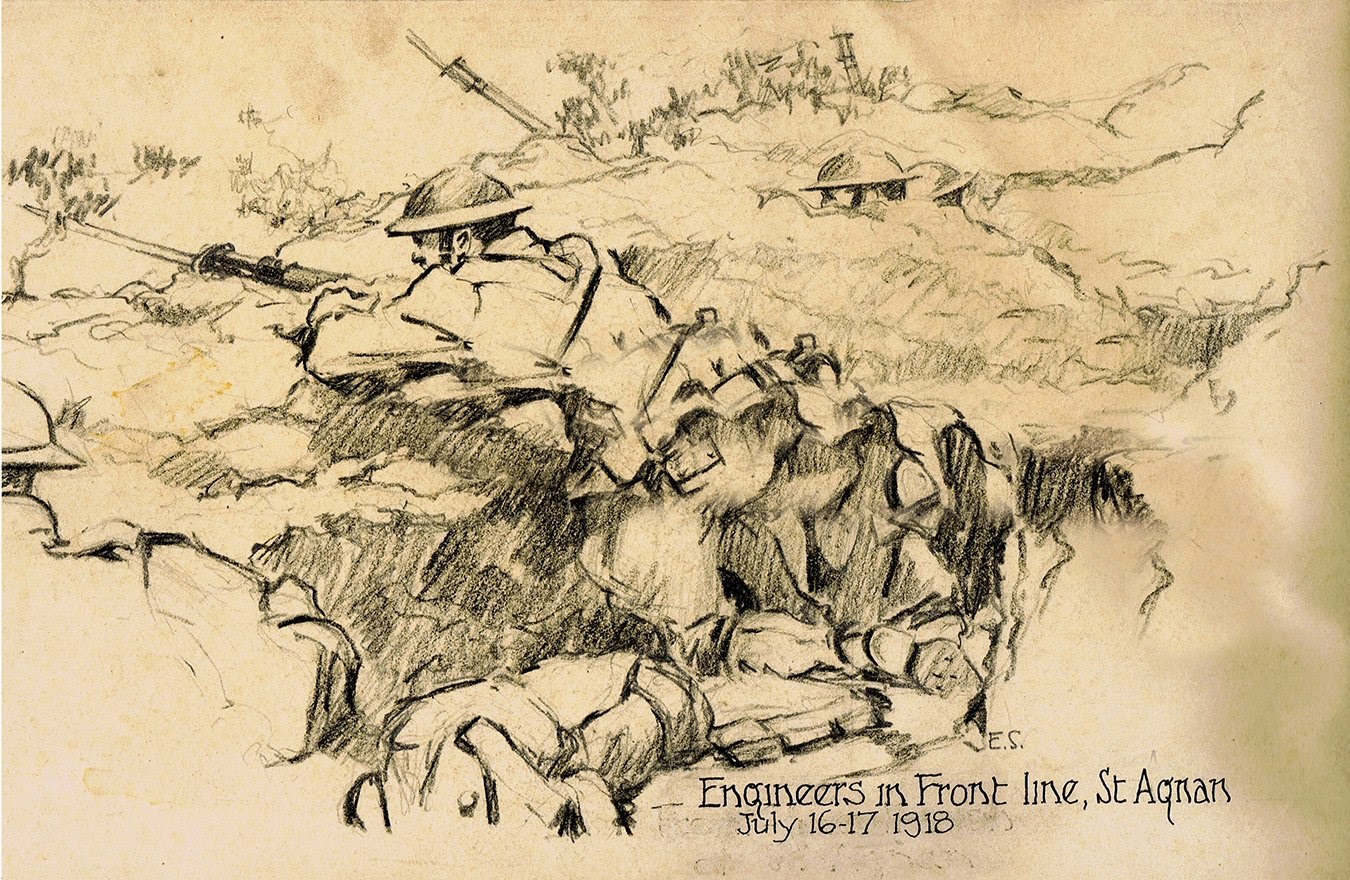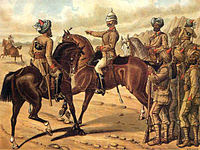






































I hope you like it!

The Marines charging in WWI
Anybody who has served can relate to this one








Now most Americans have probably never heard of this outfit. So here goes nothing! 
The Brits of the Empire Era were some pretty smart and tough cookies. Who had this knack of going into a area that they wanted to take over.
They then would beat the snot out of the locals in a pitched battle.Afterwards they then would enlist the survivors into a regiment, officered by them.
I am sure the locals figured that if you can not beat them then join them. Plus they would also get regular pay, uniforms and the prestige of the uniform of the Raj to boot.
Then the Brits would led that unit to fight the next target of opportunity for the expanding Empire. Usually their neighbors, who the locals probably hated like sin.
Bottom line, The Brits get the locals to do their fighting for them for the most part. They also cost a hell of a lot less than a British Soldier. Since one did not have to ship them over from the UK or ship them home.
They also were use to the climate and were as a bonus pretty hard fighters in their own right. I call that some very clever thinking! So here is their story below!


| Corps of Guides | |
|---|---|
 |
|
| Active | 1846–1922 |
| Country | Indian Empire |
| Branch | Army |
| Type | Joint Infantry-Cavalry |
| Part of | Bengal Army (to 1895) Punjab Command |
| Uniform | Drab; faced, 1859 drab, 1870 piped red, 1882 faced red, 1905 red velvet (officers) red cloth (soldiers), 1908 scarlet |
| Engagements | Punjab Mooltan Goojerat Delhi ALI MASJID 1879 KABUL 1878–80 AFGHANISTAN CHITRAL PUNJAB FRONTIER MALAKAND |
The Corps of Guides was a famous regiment of the British Indian Army which served in the North West Frontier and had the unique composition of being part Infantry and part Cavalry.
It evolved through the 20th century to become the Guides Cavalry.
It today exists as 2nd Battalion (The Guides) of the Frontier Force Regiment of the Pakistan Army
The brainchild of Sir Henry Lawrence, the Corps had Lt. Harry Lumsden as its commandant and W.S.R. Hodson (the Hodson of Hodson’s Horse) as second-in-command.
On 6 February 1847 Lumsden wrote to his father ” I have just been nominated to raise the corps of Guides. It will be the finest appointment in the country”.
A few months later, on 16 September 1847 Hodson wrote to his brother “..of my good fortune… I am to be the Second-in-Command with the Corps of Guides”.[2]
The Corps had modest beginnings. When it was raised at Kalu Khan, on the Yusufzai Plain, in the Peshawar Valley region by Lt. Lumsden in December 1846, it comprised just one troop of cavalry and two companies of infantry.
The first action was at Mughdara, in the Panitar Hills. Within two years, the small force of Guides had established a name for itself, under Lumsden, its founder, and Hodson .
When the Second Sikh War broke out in 1848, the unit was given authorisation for a three-fold increase in size, to six companies of infantry and three troops of cavalry.
The Guides maintained the quirky ‘cavalry and infantry combined in the same regiment’ format for many years, and even when split into two separate components, the name lingered in both elements.
The Corps of Guides became the garrison unit of a key post on the frontier, the new fort of (Hoti ~) Mardan. The building of the fort in 1854 was organised and supervised by Hodson[3] who had been promoted commandant of the regiment in 1852.[4]
In 1857 the unit was called urgently to help relieve the Siege of Delhi. In just over three weeks the Guides marched nearly six hundred miles during the hottest month of the year, crossing five great rivers and fighting four small actions.
The march coincided with the month of Ramadan meaning that the muslim soldiers in the force could neither eat nor drink during the hours of daylight.
On arrival at Delhi, the force of 600 Guides were almost immediately called upon to join the defence of the city. Men who had just completed a march of some 580 miles were thrown into a battle of such intensity that no fewer than 350 of the 600 became casualties within an hour of their arrival in Delhi.
The Corps of Guides was part of the Frontier Force brigade and developed a reputation of being an elite unit.
They were the first unit in the Indian or British Armies to dress in “khaki” uniform,[5]:537–539 first introduced in 1848. Typically, the Guides were often used in small detachments, usually supported by other Frontier Force troops.
The designations of the Corps of Guides changed over time as follows:
In 1911 the cavalry and infantry components were designated as such. The cavalry then became, successively:-
and the infantry:-
In 1945, the 12th Frontier Force Regiment was renamed the Frontier Force Regiment and on independence and the partition of India it was allocated to Pakistan.
The cavalry regiment was also allocated to Pakistan and was renamed the Guides Cavalry (Frontier Force). In 1957, the Frontier Force Rifles and The Pathan Regiment were amalgamated with the Frontier Force Regiment to form a new Frontier Force Regiment.
The Guides battalion became the 2nd battalion of the new regiment.
The Guides wore scarlet facings on the collars and cuffs of their khaki uniforms from their establishment in 1846.[10]Accordingly both
The 10th Guides Cavalry (FF) and the 2nd Battalion (The Guides) of the Frontier Force Regiment of the Pakistan Army still wear red piping on the collars of their modern dress uniforms.

Queen’s Own Corps of Guides Memorial, Cavagnari’s Arch in Mardan


Say what you will about Old Fat Hermann Goering & he deserves every bit of it!


Rest in Hell old boy!
He did try and take care of his pilots. But as you can guess due to its cost and wartime shortages. Not too many of these excellent guns were issued out to the Grunts.
Most of them becoming booty that was brought home by the GI’s & Tommy’s of WWII.


| M30 Luftwaffe Drilling[1] | |
|---|---|
| Type | Combination rifle/shotgun |
| Place of origin | Nazi Germany |
| Service history | |
| Wars | World War II |
| Production history | |
| Manufacturer | Sauer & Sohn |
| Produced | 1941–1942 |
| No. built | 2,456 |
| Specifications | |
| Weight | 7.5 pounds |
| Length | 42″ |
| Barrel length | 25.625″ |
|
|
|
| Cartridge | 9.3x74mmR, 12 Gauge[2] |
| Barrels | 3 |
| Action | Blitz lock system |
| Feed system | Manually loaded |
| Sights | Fixed |
The M30 Luftwaffe drilling (“triple”) was a survival weapon issued to Luftwaffe pilots during World War II. It was intended to be used in the event that a pilot was shot down, for defense and for hunting game to stay alive until rescue.
For maximum versatility the M30 featured two 12 gauge shotgun barrels, and a 9.3x74mmR rifle barrel. They were manufactured by the German firm JP Sauer.

Maverick Arms has discovered that a small number of Maverick Hunter™ Over/Under 12-gauge shotguns (SKU 75445) have been marked incorrectly. The chamber marking indicates that these shotguns are chambered for 3 ½” shells, however, the chambers are manufactured for 2 ¾” and 3” shells.
All Maverick Hunter™ shotguns are manufactured with 3” chambers, not 3 ½” chambers. Firing 3 ½” shot shells through these shotguns may cause an increase in chamber pressure, which may result in damage to your shotgun and/or severe personal injury if a barrel should rupture as a result of excess pressure.

Each Maverick Hunter™ shotgun is marked with a chamber designation on the right side of the barrel, just below the safety warning. If your shotgun marking reads “12 Ga 3 ½” Maverick Hunter” then your shotgun IS affected by this recall.
Discontinue use of this shotgun and immediately follow the instructions provided below.
Note that only a small number of SKU 75445 shotguns are affected. No other Maverick or Mossberg models are affected by this Safety Warning or Recall Notice.
DO NOT fire 3 ½” shot shells through your Maverick Hunter™ Over/Under shotgun.
Please call the Product Service Center at (800) 363-3555 between the hours of 8:00 AM – 4:30PM EST or email us at service@mossberg.com to confirm that your shotgun is covered by this recall.
If your shotgun is covered by this recall, Maverick Arms will provide a prepaid shipping label for your current shotgun, for return to an authorized Maverick Service Center.=
Once we receive your shotgun, Maverick will provide a free replacement shotgun of the same model and type (SKU 75445).
If you have already sold or otherwise disposed of your Maverick Hunter shotgun, we request that you immediately provide us with the contact information of the purchaser so that we may contact them directly and provide information about this recall.
For questions about this safety warning and product recall, or to confirm if your shotgun is affected by this recall, please contact the Product Service Center at (800) 363-3555.
We sincerely apologize for any inconvenience that this recall may cause, and we thank you for your patience, cooperation and support for the effort to better serve our customers.
Download PDF
Beautiful Engraved Deluxe Winchester 1895 .405 Win.
Made in 1915
I am just awe struck by the beauty of the wood on this piece. Obviously this was made for somebody with very deep pockets!